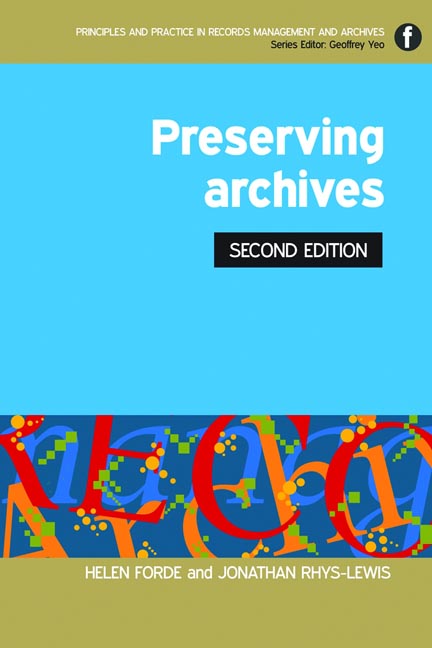Book contents
- Frontmatter
- Contents
- Introduction to the series Geoffrey Yeo
- Preface to the Second Edition
- Acknowledgements
- 1 Introducing archive preservation
- 2 Understanding archival materials and their characteristics
- 3 Managing digital preservation
- 4 Archive buildings and their characteristics
- 5 Safeguarding the building and its contents
- 6 Managing archival storage
- 7 Managing risks and avoiding disaster
- 8 Creating and using surrogates
- 9 Moving the records
- 10 Exhibiting archives
- 11 Handling the records
- 12 Managing a pest control programme
- 13 Training and the use of volunteers
- 14 Putting preservation into practice
- Appendices
- Bibliography
- British and international standards relating to archive preservation
- Index
6 - Managing archival storage
Published online by Cambridge University Press: 09 June 2018
- Frontmatter
- Contents
- Introduction to the series Geoffrey Yeo
- Preface to the Second Edition
- Acknowledgements
- 1 Introducing archive preservation
- 2 Understanding archival materials and their characteristics
- 3 Managing digital preservation
- 4 Archive buildings and their characteristics
- 5 Safeguarding the building and its contents
- 6 Managing archival storage
- 7 Managing risks and avoiding disaster
- 8 Creating and using surrogates
- 9 Moving the records
- 10 Exhibiting archives
- 11 Handling the records
- 12 Managing a pest control programme
- 13 Training and the use of volunteers
- 14 Putting preservation into practice
- Appendices
- Bibliography
- British and international standards relating to archive preservation
- Index
Summary
Introduction
The building itself may be the most important safeguard for the archives it holds but that alone is insufficient; they require additional care within this envelope. Even if the building itself is not perfect, good storage space, well maintained and managed, will make a big difference to survival. Many archives face the fact that their holdings include different media which, according to many national standards should be stored in differing temperatures and environmental conditions. For many it is impractical or impossible to comply with the requirements; compromises have to be made. In all circumstances, the types of materials stored and any external or internal factors which may affect them need to be considered, the risks need to be assessed and the best solution in the circumstances adopted.
This chapter looks in more detail at:
• why environmental conditions matter
• what needs to be controlled
• mould and how to prevent it
• measuring and monitoring conditions
• special arrangements
• costs
• shelving, racking and plan chest specifications
• boxes and enclosure specifications for different archival materials
• equipment needed
• possible future storage developments.
Why do environmental conditions matter?
Control of the environmental conditions within any archive, library or museum is crucial to the survival of the material stored within it. If the conditions are inimical the material will disintegrate even more quickly than as the result of inevitable natural decay. The purpose of controlling the temperature, relative humidity, ambient light, ultraviolet light and air quality is to ensure that such deterioration is retarded to a point at which the material is as stable as possible. It is a preventative measure which, if successful, will largely avoid the need for active intervention by conservators. Failure to maintain appropriate storage conditions may lead, among other things, to brittle paper, outbreaks of mould, fading of photographic prints or damage by particulate deposits.
There is general agreement that the more stable the conditions, the better the material will survive. Evidence suggests that even where the temperature and relative humidity levels are less than ideal, stability has been a major factor in survival. The appropriate storage levels for mixed media objects present wider challenges.
- Type
- Chapter
- Information
- Preserving Archives , pp. 71 - 98Publisher: FacetPrint publication year: 2013



